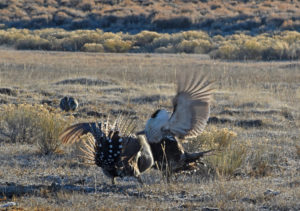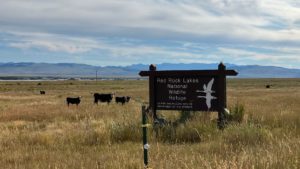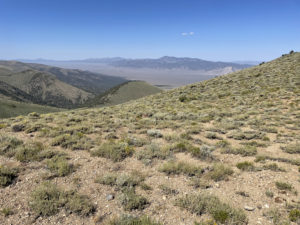For immediate release: November 10, 2025
Media contacts:
- Greta Anderson, Western Watersheds Project (520) 623-1878, greta@westernwatersheds.org
- Chris Smith, WildEarth Guardians (505) 395-6177, csmith@wildearthguardians.org
- Michelle Lute, Wildlife for All (505) 552-2501, michelle@wildlifeforall.us
- Claire Musser, Grand Canyon Wolf Recovery Project, (928) 202-1325, claire@gcwolfrecovery.org
ALBUQUERQUE, N.M. – Conservation groups are condemning the decision by the New Mexico Department of Fish and Game (NMDFG) to remove a wandering male Mexican gray wolf from the northern part of the state late last week. His removal marks the second time that the agency has tried to confine him south of Interstate 40, asserting that wolves must stay within the arbitrary bounds of the Mexican Gray Wolf Experimental Population Area (MWEPA), which represents only some of the suitable wolf habitat in the Southwest and which was delineated for political rather than scientific reasons.
The wolf was named “Taylor” by conservation groups in honor of Mount Taylor, a place considered sacred by numerous southwestern Tribes, and where this wolf was originally encountered in May 2025 and to where he returned in July 2025 after his first translocation south into the Gila National Forest. He is the fifth wolf in recent years to venture north in New Mexico, and his “out-of-bounds” journey over the last four months has been free of conflict with humans. His recent movements suggested that he might be looking for a mate; January is the start of breeding season for this species.
“It’s ridiculous to keep moving wolves back south of Interstate 40 when wolves have clearly decided there’s great habitat to the north of the highway,” said Greta Anderson, deputy director of Western Watersheds Project. “We fully expect that, like Asha before him, he’ll head right back to his northern territory. We can’t explain his desire, but we shouldn’t deny his instincts.”
“Wildlife should be wild and free,” said Chris Smith, wildlife program director for WildEarth Guardians. “Lobos are going to eventually re-establish in northern New Mexico, as they should. Enforcing arbitrary boundaries to keep wildlife where humans want them is not just a silly game–it is a threat to recovery.”
Independent wolf biologists have recommended that Mexican wolf dispersal to or reintroduction efforts in the southern Rocky Mountains of northern New Mexico and southern Colorado are necessary in order for the species to be recovered. Because Northern Rockies gray wolves, now reintroduced to Colorado, are close relatives capable of interbreeding with Mexican gray wolves, northern expansion is considered a critical element of long-term recovery. Allowing these populations to meet where their historical ranges overlap will restore natural gene flow and strengthen the long-term viability of both lineages.
Despite recovery science establishing the need for multiple, connected populations of Mexican wolves, state and federal agencies continue to enforce artificial boundaries and do not allow wolves north of Interstate 40 where suitable habitat abounds.
“Taylor is confirming what scientists and conservationists have been saying: wolves need room to roam, disperse, and find mates,” said Michelle Lute, PhD in wolf conservation and executive director of Wildlife for All. “These processes function at the landscape scale and cannot be constrained by administrative boundaries. Wolves like Taylor are expanding their range naturally, and the science is clear: recovery requires connectivity. We need wildlife governance that respects biology, not bureaucratic borders.”
“Taylor is charting his own path across ancestral landscapes, just as wolves have always done. Agencies claimed Asha had no mate in northern New Mexico, yet by removing every wolf who ventures north of I-40, they guarantee she never will,” said Claire Musser, executive director, Grand Canyon Wolf Recovery Project. “True recovery requires giving lobos the freedom to disperse, to find family, and to shape their own futures on their own terms.”
“Taylor should not have been captured,” said Michael Robinson of the Center for Biological Diversity. “Mexican wolves need more room to roam, not confinement behind arbitrary political lines.”
“We’ve long known that the political boundaries imposed on Mexican gray wolf recovery do not match ecological ones, and that this poses a significant hindrance to recovery. We have an opportunity here to advance recovery efforts by simply allowing Taylor—and other lobos—to wander north into historic and suitable habitat, and yet we expend significant resources time and time again preventing just that,” said Luke Koenig, Gila grassroots organizer for New Mexico Wild.
“We’ve long known that the political boundaries imposed on Mexican gray wolf recovery do not match ecological ones, and that this poses a significant hindrance to recovery. We have an opportunity here to advance recovery efforts by simply allowing Taylor—and other lobos—to wander north into historic and suitable habitat, and yet we expend significant resources time and time again preventing just that,” said Luke Koenig, Gila grassroots organizer for New Mexico Wild.
##






